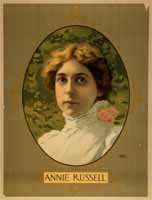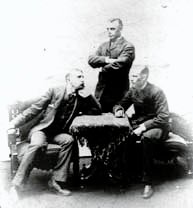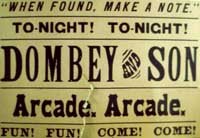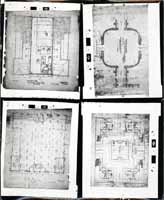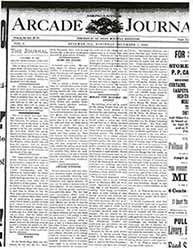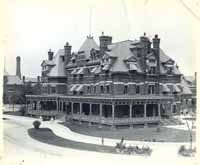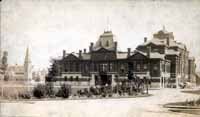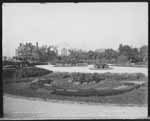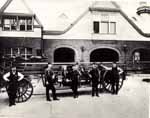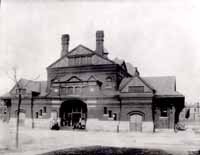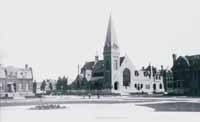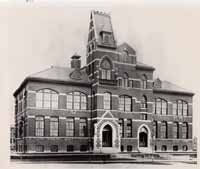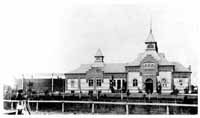The Arcade Theater
You are at Home -> The Town of Pullman -> The Arcade -> The Arcade TheaterThe Arcade Theater
The 1,000 seat theater in the Arcade was dedicated on Jan. 9, 1883, to great pomp and ceremony. The guests of honor, which included Pullman, John Crerar, and General P. H. Sheridan, arrived by special train, consisting of 6 brand new coaches. The guests were met by the Pullman band under an awning run out to the tracks for the occasion. As the Tribune reported at the time (Jan. 10, 1883): "Both ladies in gentlemen were in full dress, and the broad staircase, vestibule, and foyer, thronged with the gaily-dressed crowd, presented a festive appearance" After a brief speech by Pullman and a 20-minute opening address by General Stewart L. Woodford, the curtain rose at 8:30 p.m. to the play Esmerelda, performed by the Madison Square Company from New York. [26] Woodford would shortly assume the 3rd congressional seat in New York, and would become, in 1897-98, the "United States Envoy Extraordinary and Minister Plenipotentiary to Spain" (an unenviable position just ahead of the Spanish-American War). [27] The play Esmerada was certainly a popular play in its day and a crowd pleasing choice for an opening of a theater; the Cornell Daily Sun wrote that Esmeralda is a remarkable work. Surely no drama was ever more free from artifice and guile. (April 19, 1883, p. 3). The critic George Odell called it a "sweet, harmless play." It was adapted from a novelette by Francis Hodgson Burnett by Burnett and William Gillette. Burnett, of course, went onto write such works as Little Lord Flaunteroy and The Secret Garden. The plot consists of trials and eventual triumph of the love between the North Carolina farm girl Esmeralda and her neighbor, Dave Hardy. The play was the first major production for the actress Annie Russell. The Chicago Tribune wrote that Miss Annie Russell... [is] still quite young, very pretty, and graceful, and with proper training will be heard from. (April 24, 1883, p. 5) One of the actors also appearing was probably the famous actor John Edward Owens who starred in the Madison Square Company's production in 1882. The Chicago Tribune's depiction of that opening day described the elegance of the Theater. Its entrance was reached by "ascending a massive stairway" on the west side of the Arcade Building. The foyer and hallway ceiling of the theater entrance was painted sky blue with stars painted on it. A giant gas chandelier hung from the frescoed ceiling inside the theater, which had five elegantly decorated boxes on each side of the main seating area, extending from a balcony. Seats in the orchestra were covered in red leather, and the whole Theater was decorated in a Moroccan/Persian motif.
Composited image of the Arcade Theater.
Note that this image was created from Photoshop by melding together 2 Johnson photographs.
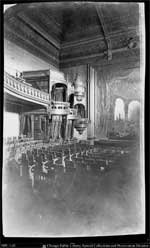
Private boxes in the Arcade Theater, also known as the Pullman Opera House.
Photo courtesy Special Collections and Preservation Division, Chicago Public Library, HPC 1.42.
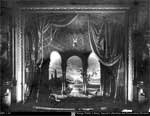
Stage and curtain in the Arcade Theater.
Photo courtesy Special Collections and Preservation Division, Chicago Public Library, HPC 1.43.
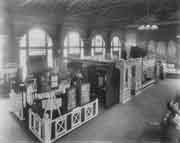
The stage curtain can also be seen in a 1915 photo gracing the wall of the Palmer Park Field House, Pullman neg. P.18710, Chicago Historical Society.
THE PULLMAN HISTORY SITE

More Information About the Town of Pullman
Planning the town
The Arcade Journal
The Hotel Florence
The Arcade
Arcade Park
The Stables
Market Hall
Area Churches
Area Schools
The Freight Depot and the Railway Station
Other Pullman Buildings
The Pullman House History Project
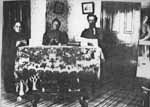
Arranged by:
Name
Address
Occupation
Birthplace
People of Color
Maps of Pullman
Images of the Town of Pullman
All images of the town
Vistas
Art & Architecture
- Landscape architect Nathan Franklin Barrett
- Architect Solon Spencer Beman
- Henry Koopman and Family, Photographer
- Landscape Design
Pullman’s Neighborhood
- The Calumet River
- IHACCR
- Area Churches
- The Kensington Neighborhood
- Lake Calumet
- North Pullman
- The Roseland Neighborhood
Buildings in Pullman
- The Arcade Building
- Arcade Park
- Carriage House
- Casino Building
- Fire Department
- Freight Depot
- Gas Works
- The Hotel Florence
- Hospital
- Houses
- Market Hall
- Schools
- Stable
- Train Station
Other Pullman-Related Sites
- Historic Pullman Garden Club - An all-volunteer group that are the current stewards of many of the public green spaces in Pullman. (http://www.hpgc.org/
- Historic Pullman Foundation - The HPF is a non-profit organization whose mission is to "facilitate the preservation and restoration of original structures within the Town of Pullman and to promote public awareness of the significance of Pullman as one of the nation's first planned industrial communities, now a designated City of Chicago, State of Illinois and National landmark district." (http://www.pullmanil.org/)
- The National A. Philip Randolph Pullman Porter Museum is a 501(c)3 cultural institution. Its purpose is to honor, preserving present and interpreting the legacy of A. Philip Randolph, Pullman Porters, the Brotherhood of Sleeping Car Porters and the contributions made by African-Americans to America's labor movement. ((http://www.nationalpullmanportermuseum.com/)
- Pullman Civic Organization - The PCO is a strong and vibrant Community Organization that has been in existence since 1960. (http://www.pullmancivic.org/)
- Pullman National Monument - The official page of the Pullman National Park. (https://www.nps.gov/pull/)
- South Suburban Genealogical & Historical Society - SSG&HS holds the Pullman Collection, consisting of personnel records from Pullman Car Works circa 1900-1949. There are approximately 200,000 individuals represented in the collection. (https://ssghs.org/)
- The Industrial Heritage Archives of Chicago's Calumet Region is an online museum of images that commemorates and celebrates the historic industries and workers of the region, made possible by a Library Services and Technology Act grant administered by the Illinois State Library. (http://www.pullman-museum.org/ihaccr/)
- Illinois Digital Archives (IDA) is a repository for the digital collections libraries and cultural institutions in the State of Illinois and the hosting service for the online images on this site. (http://www.idaillinois.org/)
